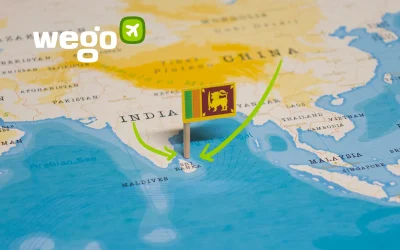This article is reviewed regularly (on a monthly basis) by Wego’s editorial team to ensure that the content is up to date & accurate.
Updated 3 November 2021
Staying extremely vigilant to steer away from the pandemic, the United States had greatly restricted travel to and from the country for more than a year. Thankfully, the land of the free has now opened up for travellers, putting an end to travel restrictions lasting over 21 months.
The US has also classified countries assessing current infection levels and safety. So which countries are on the US’ green list? Can you travel to the US for leisure? Here is the latest information on the US green list 2021.
Table of Contents
Does the US have a green list?
The Centers for Disease Control and Prevention (CDC) has not precisely formulated a green list of countries yet. However, all countries have been classified under 4 levels, according to the COVID-19 risk assessment.
Countries listed under “Level 1” have low infection levels, and the government advises travellers to get fully jabbed before travelling to such countries.
- American Samoa
- Bhutan
- Chad
- China
- Comoros
- Falkland Islands
- Guinea
- Hong Kong SAR
- Indonesia
- Kuwait
- Kyrgyzstan
- Madagascar
- Mali
- Marshall Islands
- Micronesia, Federated States of
- Montserrat
- New Zealand
- Niger
- Northern Mariana Islands
- Oman
- Palau
- Paraguay
- Saba
- Saint Barthelemy
- Saint Pierre and Miquelon
- Senegal
- Sierra Leone
- Sint Eustatius
- Taiwan
- Zambia
US entry requirements
If you are looking to travel to the United States, here are a few things you should keep in mind prior to travel:
- You must be fully vaccinated to travel to the United States by plane if you are a non-U.S. citizen, non-U.S. immigrant (not a U.S. citizen, U.S. national, lawful permanent resident, or travelling to the United States on an immigrant visa). Only limited exceptions apply.
- You are required to show a negative COVID-19 test result or documentation of recovery from COVID-19 when you travel to the United States by air. The timing of this test depends on your vaccination status and age.
- Wearing a mask over your nose and mouth is required in indoor areas of public transportation (including aeroplanes) travelling into, within, or out of the United States and indoors in U.S. transportation hubs (including airports).
Vaccination criteria
The US approves any FDA-authorized vaccine or a vaccine authorized for emergency use by the World Health Organization for entry to the country. You are considered fully vaccinated if:
- 2 weeks (14 days) after your dose of an accepted single-dose COVID-19 vaccine.
- 2 weeks (14 days) after your second dose of an accepted 2-dose series COVID-19 vaccine; or
- 2 weeks (14 days) after you received the full series of an “active” (not placebo) COVID-19 vaccine in the U.S.-based AstraZeneca or Novavax COVID-19 vaccine trials
- 2 weeks (14 days) after you received 2 doses of any “mix-and-match” combination of accepted COVID-19 vaccines administered at least 17 days apart
Testing requirements
If you plan to travel to the United States by air, you will need to get a COVID-19 viral test (regardless of vaccination status) beforehand. You must show your negative result to the airline before you board your flight.
For fully vaccinated travellers, the test must be conducted on a sample taken no more than 3 days before the flight’s departure from a foreign country if they show proof of being fully vaccinated against COVID-19.
For partially vaccinated travellers, the test must be conducted on a sample taken no more than 1 day before the flight’s departure from a foreign country if they do not show proof of being fully vaccinated against COVID-19.
Passengers must be tested with a viral test that could be either an antigen test or a nucleic acid amplification test (NAAT). Rapid tests are also acceptable as long as they are viral tests. This includes:
- reverse transcription-polymerase chain reaction (RT-PCR)
- reverse transcription loop-mediated isothermal amplification (RT-LAMP)
- transcription-mediated amplification (TMA)
- nicking enzyme amplification reaction (NEAR)
- helicase-dependent amplification (HDA)
- The test used must be authorized for use by the relevant national authority to detect SARS-CoV-2 in the country where the test is administered.
The test result must be written documentation, either on printed paper or as an electronic copy. It must be authorized for use by the relevant national authority to detect SARS-CoV-2 in the country where the test is administered.
Quarantine requirements
Quarantine rules vary depending on your vaccination status. If you are fully vaccinated, you need not quarantine but you should:
- Get tested with a viral test 3-5 days after travel. If your test is positive, isolate yourself to protect others from getting infected.
- Self-monitor for COVID-19 symptoms; isolate and get tested if you develop symptoms.
Travellers who are not fully vaccinated must:
- Get tested with a viral test 3-5 days after travel and stay home and self-quarantine for a full 7 days after travel.
- Even if you test negative, stay home and self-quarantine for the full 7 days.
- If your test is positive, isolate yourself to protect others from getting infected.
- If you don’t get tested, stay home and self-quarantine for 10 days after travel.
- Avoid being around people who are at increased risk for severe illness for 14 days, whether you get tested or not.
- Self-monitor for COVID-19 symptoms; isolate and get tested if you develop symptoms.













